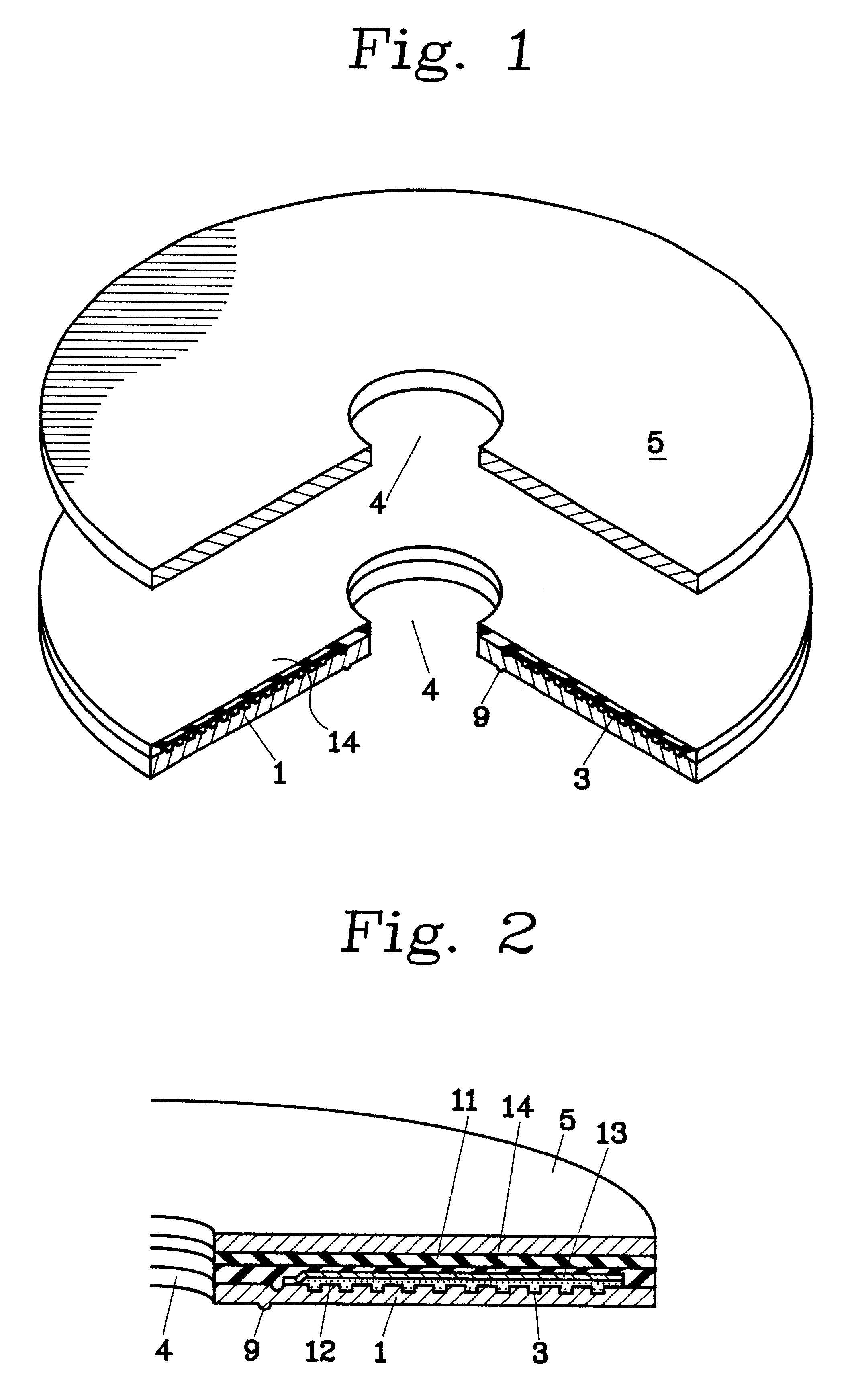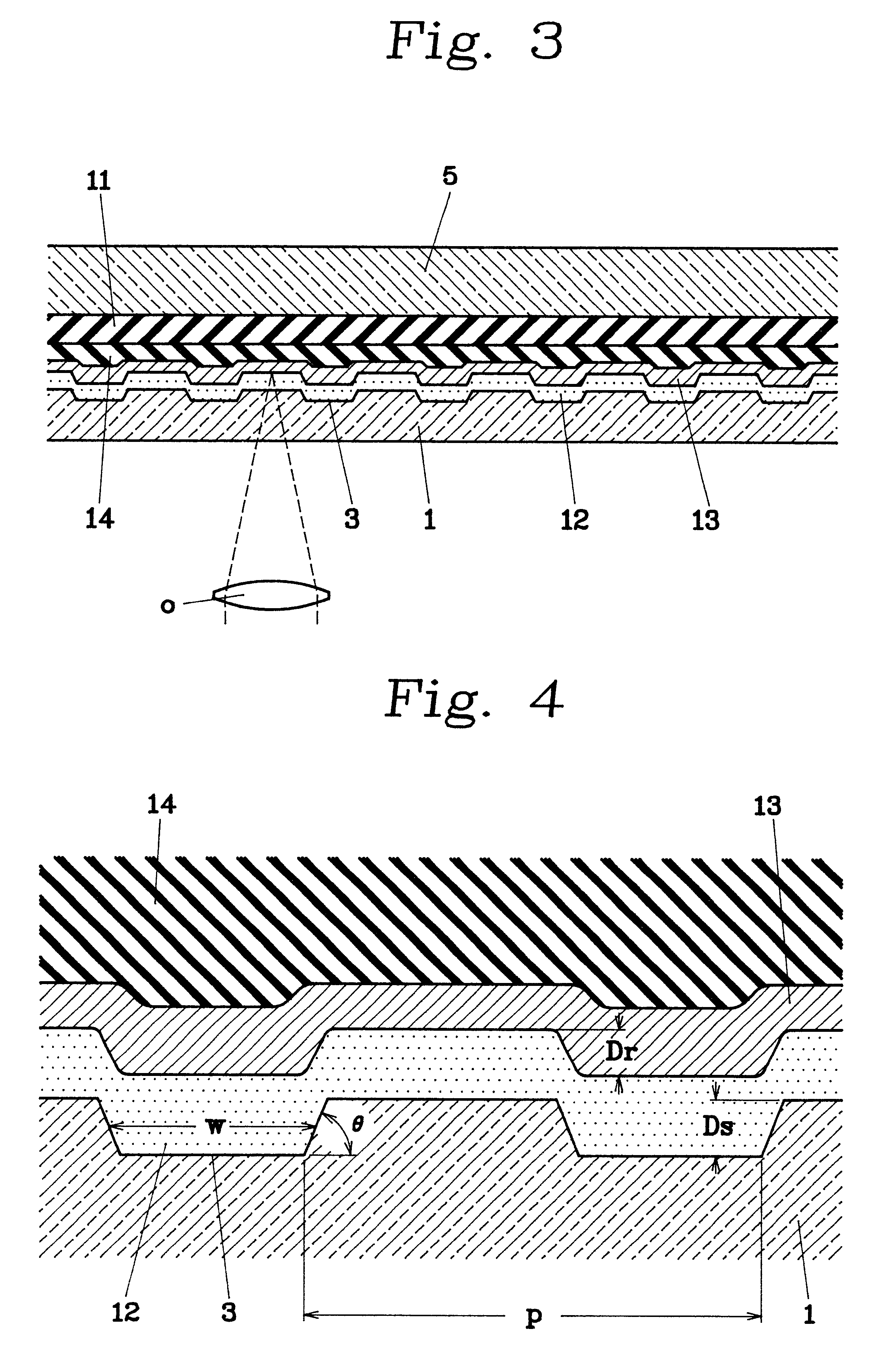Optical information medium and recording method therefor
a technology of optical information and recording method, applied in the field of optical information medium, to achieve the effect of high density
- Summary
- Abstract
- Description
- Claims
- Application Information
AI Technical Summary
Benefits of technology
Problems solved by technology
Method used
Image
Examples
example 1
A transparent substrate 1 having a groove 3 for tracking on one side of the main surfaces, of 0.31 .mu.m in FWHM, 140 nm in depth, 65.degree. in inclination angle at both edges of groove, and 0.74 .mu.m in pitch, is prepared from a polycarbonate substrate of 120 mm.psi. in outer diameter, 15 mm.psi. in inner diameter, 0.597 mm in thickness, and 1.59 in refractive index.
On the side surface of the transparent substrate 1, having the groove 3 thereon, the recording layer 12 is formed by the spin coating film formation of a solution of cyanine dye (trimethylene dye).
The depth in position of the groove 3 mentioned above is 105 nm in the recording layer 12, and the index for film thickness of the land / groove of the recording layer is .varies.=1-Dr / Ds=0.25. Also, the FWHM of the groove 3 is 0.31.mu.m as mentioned in above, therefore, it is approximately 42% of the pitch of the groove 3, i.e., 0.74 .mu.m.
Further, Au is spattered onto the recording layer 12 so as to form the reflective layer...
example 2
The optical information medium is produced in the same manner to that of Example 1 mentioned above, but the groove 3 for tracking on the main surface of the transparent substrate 1 is determined to be 0.28 .mu.m in FWHM, 200 nm in depth, and 57.degree. in inclination angle at both edges of the groove thereof, everything else being the same as in Example 1 mentioned above.
The depth at the position of the groove 3 mentioned above is 135 nm in the recording layer 12, and the index for film thickness of the land / groove of the recording layer is .varies.=1-Dr / Ds 0.33. Also, the FWHM of the groove 3 is 0.28 .mu.m as mentioned above, therefore, it is approximately 39% of the pitch of the groove 3, i.e., 0.74 .mu.m.
On the optical information medium produced in this manner, an EFM-Plus signal is recorded at a recording power of 12 mW and wavelength of 655 nm, by using an optical pickup having the objective lens (o) of NA 0.66, in the same manner as Example 1 mentioned above. After being reco...
example 3
The optical information medium is produced in the same manner as in Example 1 mentioned above, but the groove 3 for tracking on the main surface of the transparent substrate 1 is determined to be 0.35 .mu.m in FWHM, 200 nm in depth, and 72.degree. in inclination angle at both edges of the groove, everything else being the same as in Example 1 mentioned above.
The depth at the position of the groove 3 mentioned above is 125 nm in the recording layer 12, and the index for the film thickness of the land / groove of the recording layer is .varies.=1-Dr / Ds =0.38. Also, the FWHM of the groove 3 is 0.35 .mu.m as mentioned above, therefore, it is approximately 47% of the pitch of the groove 3, i.e., 0.74 .mu.m.
On the optical information medium produced in this manner, an EFM-Plus signal is recorded at a recording power of 10 mW and wavelength of 635 nm, by using an optical pickup having the objective lens (o) of NA 0.64, in the same manner as Example 1. After being recorded thereon, the signal...
PUM
| Property | Measurement | Unit |
|---|---|---|
| wavelength | aaaaa | aaaaa |
| thickness | aaaaa | aaaaa |
| wavelength | aaaaa | aaaaa |
Abstract
Description
Claims
Application Information
 Login to View More
Login to View More - R&D
- Intellectual Property
- Life Sciences
- Materials
- Tech Scout
- Unparalleled Data Quality
- Higher Quality Content
- 60% Fewer Hallucinations
Browse by: Latest US Patents, China's latest patents, Technical Efficacy Thesaurus, Application Domain, Technology Topic, Popular Technical Reports.
© 2025 PatSnap. All rights reserved.Legal|Privacy policy|Modern Slavery Act Transparency Statement|Sitemap|About US| Contact US: help@patsnap.com



